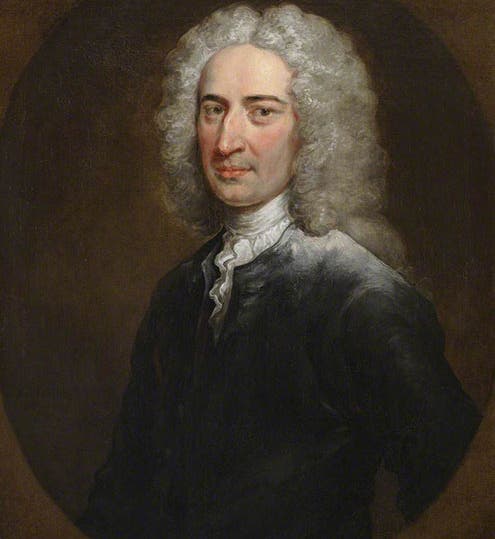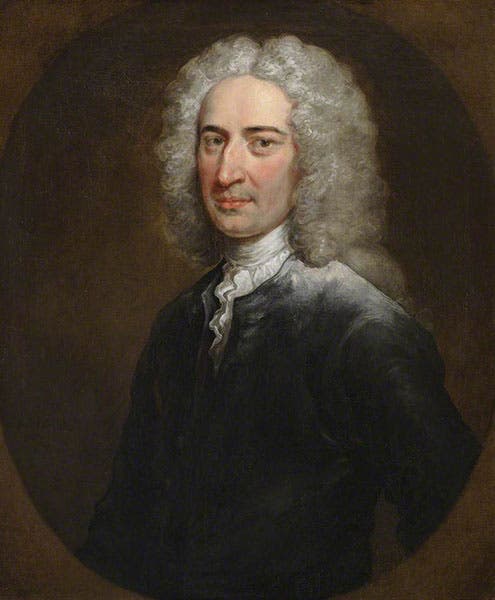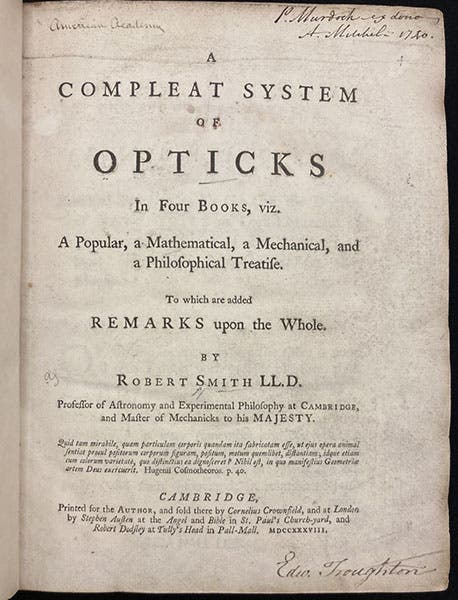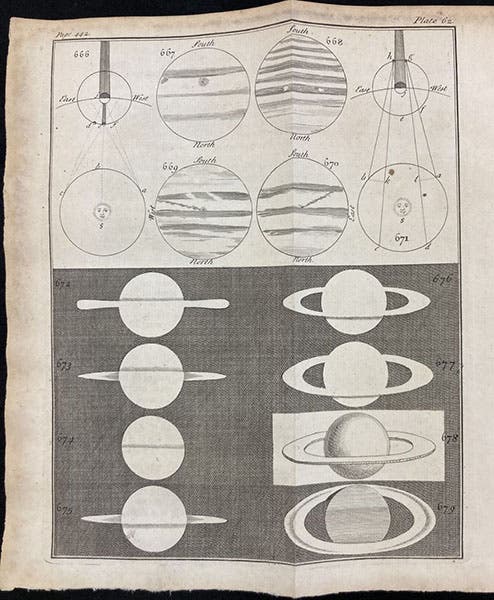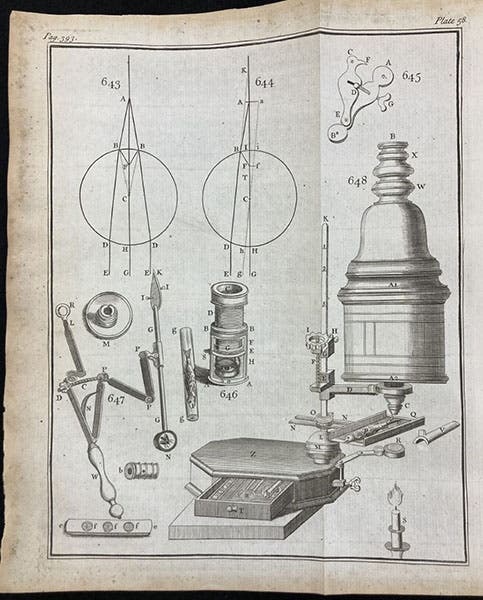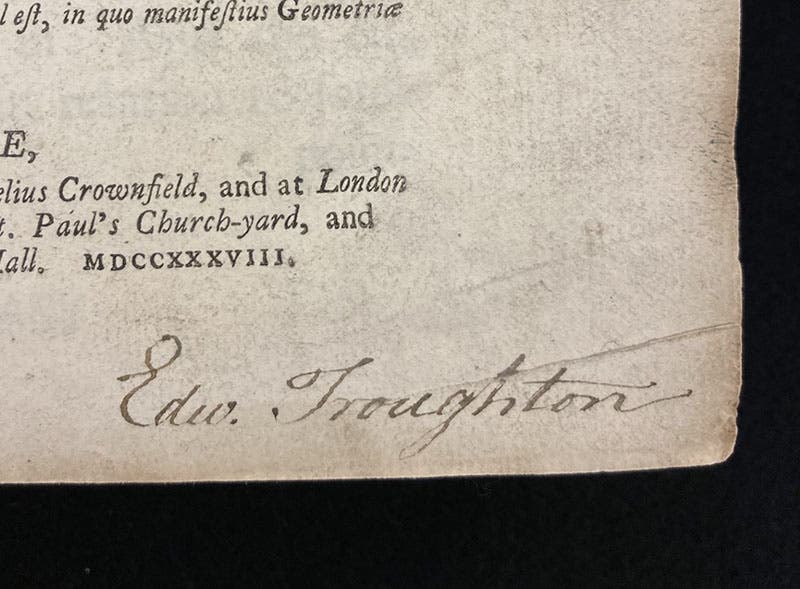Scientist of the Day - Robert Smith
Robert Smith, an English mathematician, died Feb. 2, 1768, at the age of 78. Smith attended Trinity College, Cambridge, where Isaac Newton had studied and taught, and became, in succession, fellow, senior fellow and, in 1742, Master of the college. He also held the Plumian Chair of Astronomy at Cambridge from 1716 until he retired in 1760, not quite the Lucasian Chair, but a respected professorship, nevertheless.
Smith seems to have been more interested in applied mathematics than the abstract variety, for his most popular books were on optics and harmonics. We will focus here on his Compleat System of Opticks (1738), an enormously popular book among telescope makers, a copy of which we have in our history of science collection.
Newton's Opticks had been published in 1704, just four years before Smith matriculated at Trinity. Although Newton had resigned his chair in 1702, it would seem that Smith grew up with the ghost of Newton Past, for his book is a paean to Newtonian optics. Newton had invented one of the first reflecting telescopes, and he built his own instrument, grinding the mirror from a speculum disc that he cast himself. Smith apparently greatly admired this combination of the theoretical and the practical. So in his Compleat System, Smith included a long section giving advice about how to choose a speculum recipe for your mirror, how to cast it, and how to go about giving it a proper figure. This was unusual in optics textbooks, where typically there was a lot of ray-tracing with diagrams but very little practical advice about grinding lenses or mirrors. That was because lens-making was a craft and the methods used were trade secrets, not to be revealed in print. That changed after Newton, as many gentlemen began to make their own telescopes, and they were happy to tell others how they had done so.
Accordingly, Smith included in his book a long section by Samuel Molyneux, James Bradley, and James Hadley about how to make a reflecting telescope, detailing the results of experiments with hundreds of different recipes for speculum metal and providing descriptions of grinding and polishing procedures. Christiaan Huygens, even before Newton, had made his own telescopes, but his descriptions were not available to others, until Smith included them in his book.
Smith’s book was richly illustrated with scores of line engravings that showed ray-tracing, grinding machines, actual telescopes, what you will see through a well-made telescope (as with the engraving of the faces of Jupiter and Saturn), and other optical devices, such as magic lanterns and microscopes. We have included a few of those engravings in this post.
Later would-be telescope makers took Smith’s Opticks as their operating Bible. One notable example was William Herschel. Herschel was trained as a musician, and after he came to England in 1756, he read Smith's book on harmonics. This probably led him to Smith's Opticks, and even though he had no previous aspirations that we know of for building his own telescope before reading Smith, he certainly did afterward, and he was successful, constructing first a small Newtonian reflector (small means only 7-feet long), with which he discovered Uranus in 1781, and then larger (20-foot and 40-foot) reflectors with which he mapped thousands of nebulae. We have in our Library an early commonplace book kept by Herschel, a manuscript in which he copied out excerpts from his reading or provided details of optical experiments. Page 3 of this diary begins with a long extract from Smith’s Opticks (seventh image). This is what got him started on his own astronomical career.
Another telescope maker who profited from Smith’s Opticks was Edward Troughton, a successful London instrument maker of the later 18th century, who would built a transit instrument for Greenwich Observatory that is still on display there (see our post on Troughton). We know that Troughton owned a copy of Smith’s Opticks, and presumably read it, because his signature is at the bottom of the title page of our copy (eighth image). That is a very satisfying provenance.
When Smith died in 1768, he was buried in Trinity College Chapel at Cambridge, where there also hangs a fine portrait, painted in 1730 by John Vanderbank (first image). Vanderbank, 4-5 years earlier, had painted the last portraits of an octogenarian Isaac Newton. That is a satisfying connection as well. We wrote a post on Vanderbank several years ago, but at the time, I was not aware that he had done the Smith portrait, so I did not include it there, which is perhaps just as well, as things turned out.
William B. Ashworth, Jr., Consultant for the History of Science, Linda Hall Library and Associate Professor emeritus, Department of History, University of Missouri-Kansas City. Comments or corrections are welcome; please direct to ashworthw@umkc.edu.

